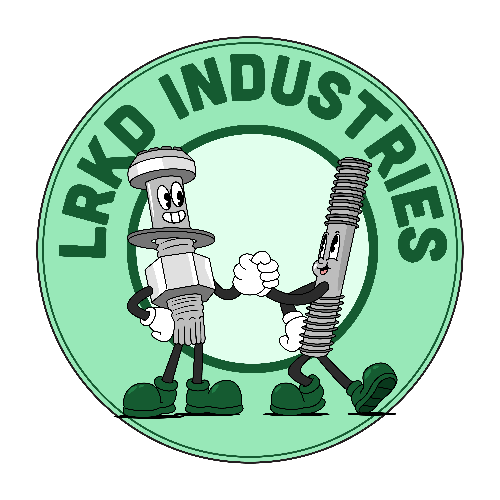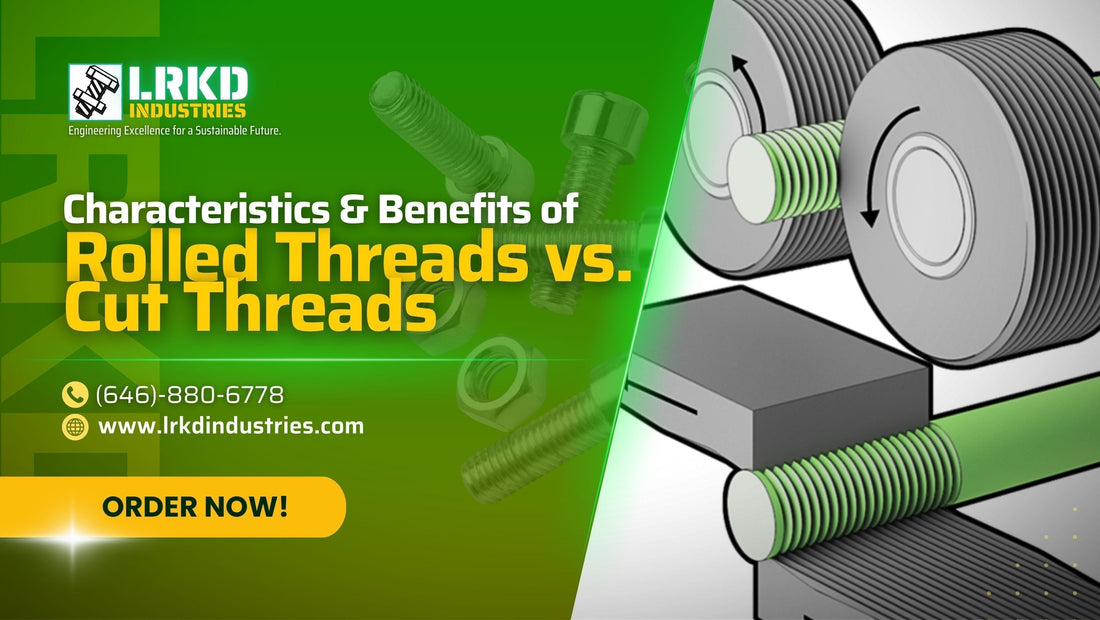Rolled threads possess enhanced physical properties, improved accuracy, and a high-quality surface finish. They are consistently manufactured at high production rates without material waste. These six key advantages have led to the growing popularity of thread rolling.
THE THREAD ROLLING PROCESS
Thread and form rolling is a straightforward cold forging process primarily used for producing external threads. It is classified as a cold forging process because it is typically performed on cold blanks, though rolling threads or heated blanks has proven advantageous in certain applications. Today, many industries recognize thread and form rolling as the preferred method for creating uniform, smooth, and precise threads with superior physical properties.
The process utilizes hardened steel dies to form the threads. The threaded surfaces of these dies are pressed against the circumference of plain cylindrical blanks, reshaping the blank's surface into threads as it rolls along the die faces (Fig. 1). The working faces of the dies contain a thread form that is the reverse of the desired thread. As the dies penetrate the blank's surface, they displace the material to create the thread roots and force the displaced material outward radially to form the thread crests. The blank’s diameter is intermediate between the thread's major and minor diameters.
A comparison of cut and rolled threads is shown in Fig. 2. Unlike other threading methods, thread rolling does not remove material, and therefore, no chips are generated
PHYSICAL CHARACTERISTICS
The cold forging process involved in thread rolling strengthens threads in terms of tension, shear, and fatigue resistance.
TENSILE STRENGTH
Cold working during thread rolling increases the tensile strength of the material. Static tensile tests often demonstrate improvements of approximately 10% in the breaking strength of components.
SHEAR STRENGTH
Unlike other screw thread production methods, rolling does not sever the material fibers. Instead, as illustrated in Fig. 3 Cut Threads, the fibers are reshaped into continuous, unbroken lines following the thread contours, similar to high-quality forging (Fig. 4 Rolled Threads). This method enhances resistance to stripping since shear failures occur across the grain rather than along it.
RESISTANCE TO FATIGUE
Thread rolling improves resistance to fatigue failure through multiple mechanisms. The process creates threads with smooth, burnished roots and flanks, free from tears, chatter, or cutter marks that might act as stress concentrators and lead to fatigue failure.
Additionally, the surface layers of the threads, particularly at the roots, are left in a state of compressive stress. These stresses must be overcome before tensile stresses, which cause fatigue failure, can develop. The resulting increase in root hardness—by as much as 30%—significantly enhances fatigue resistance.
It has been consistently proven that a fastener installed with proper tightening and maintaining that tightness throughout its service life is significantly less likely to fail due to fatigue compared to one that is either loosely assembled or becomes loose during use.
Threads created through cutting methods tend to have surface imperfections, such as partially torn-away particles. These imperfections wear down over time, causing the fastener to loosen. In contrast, rolled threads are compacted and burnished during the threading process, making them less prone to loosening and generally offering a longer fatigue life.
Rolled threads retain their fatigue strength even after being exposed to temperatures up to 500°F for several hours. Conversely, threads produced by other methods can experience a reduction in fatigue strength of up to 25% under similar conditions.
The combined benefits of these factors result in an improvement in fatigue strength, often reported to be between 50% and 75%. For heat-treated bolts with a Rockwell hardness of C36 to C40, where the threads are rolled after heat treatment, testing shows an increase in fatigue strength by a factor of 5 to 10 compared to cut threads.
ACCURACY
Achieving precise threads requires stringent control over pitch diameter, thread angle, lead, taper, roundness, and drunkenness.
Rolling offers inherent advantages in achieving and maintaining accuracy for pitch diameter, thread angle, lead, and taper. Moreover, this process ensures long-term consistency. While controlling roundness and drunkenness is no easier with rolling than with other methods, it is typically manageable by the average operator.
(Refer to Fig. 5 for additional clarity and illustrations.)
THREAD ANGLE AND LEAD
The precision of the thread angle and lead, as illustrated in Fig. 6, largely depends on the accuracy of the dies. In most instances, the thread angle and lead of the thread on the die are precisely replicated on the rolled material.
The setup of the dies and the properties of the rolled material can also affect the accuracy of the lead produced. Harder and stiffer materials may exhibit a slight "spring back" after rolling, causing a minor contraction in the lead on the workpiece. To address this, dies with an expanded lead can be utilized, consistently producing threads with the correct lead.
 DRUNKENNESS
DRUNKENNESS
The control of drunkenness is achieved through the precise application of several key factors. First, it is essential to use dies with correctly designed lead angles to ensure optimal performance. Additionally, careful matching of the components is required to maintain alignment and functionality. Proper feeding of the blank into the dies and its precise positioning in relation to them are equally critical to avoid errors or irregularities in the process. For a visual representation and further clarity, refer to Fig. 7.
 ROUNDNESS
ROUNDNESS
Achieving roundness depends on both the inherent shape and uniform hardness of the blank, as well as the rate at which the die pressure is applied and released. When the dies are engineered to gradually and evenly apply and relieve pressure, tight roundness tolerances can be consistently maintained. Refer to Fig. 8.
UNIFORMITY
With careful handling, highly accurate threads can be achieved using common threading methods. However, thread rolling stands out due to its unique capability to maintain setup accuracy throughout extended high-speed production runs.
The thread form on a set of thread rolling dies is consistently replicated on the parts and remains virtually unchanged over the entire lifespan of the dies. Unlike other threading tools, thread rolling dies do not experience concentrated wear on sharp cutting edges. Instead, wear is distributed over a broad surface, and the rolling action minimizes friction. Consequently, the thread form of a rolling die is not affected by erosion, dullness, or adhesion, nor does it require sharpening, eliminating the possibility of errors from improper sharpening.
The thread rolling process and its equipment are continually evolving. Interest and innovation in this field are at an all-time high, with new machines and attachments being developed. This process is increasingly applied to reduce costs and enhance the quality of countless threaded parts by leveraging its speed, accuracy, uniformity, and the added strength it imparts to the rolled components.
Unlocking Superior Thread Performance
Save your detailers some time! Whether it's for a bid or an ongoing project, understanding the difference between rolled and cut threads can make a significant impact on material selection and project performance. At LRKD Industries, we provide expert guidance and technical support to help you choose the right threading method based on your structural demands and operational needs.
Rolled threads offer:
Improved fatigue resistance
Smoother surface finish
Greater thread strength due to grain flow
Cost-effectiveness for high-volume production
Cut threads provide:
Precision for small runs or custom specs
Compatibility with hardened materials
Flexibility in thread profiles
Let LRKD Industries help you determine the ideal solution for your application!
👉 Submit your specs today for a FREE consultation on thread type evaluation.
📍 Address: 98 N Industry CT, Deer Park, NY 11729, US
📞 Phone: +1 646-880-6778
📧 Email: info@lrkdindustries.com
We can also deliver threading designs in “.dwg” format, fully compatible with Tekla Structures for seamless integration with your modeling and fabrication systems.
For more information about our threaded fastener solutions, click here.
When precision matters, the right threads make all the difference.


